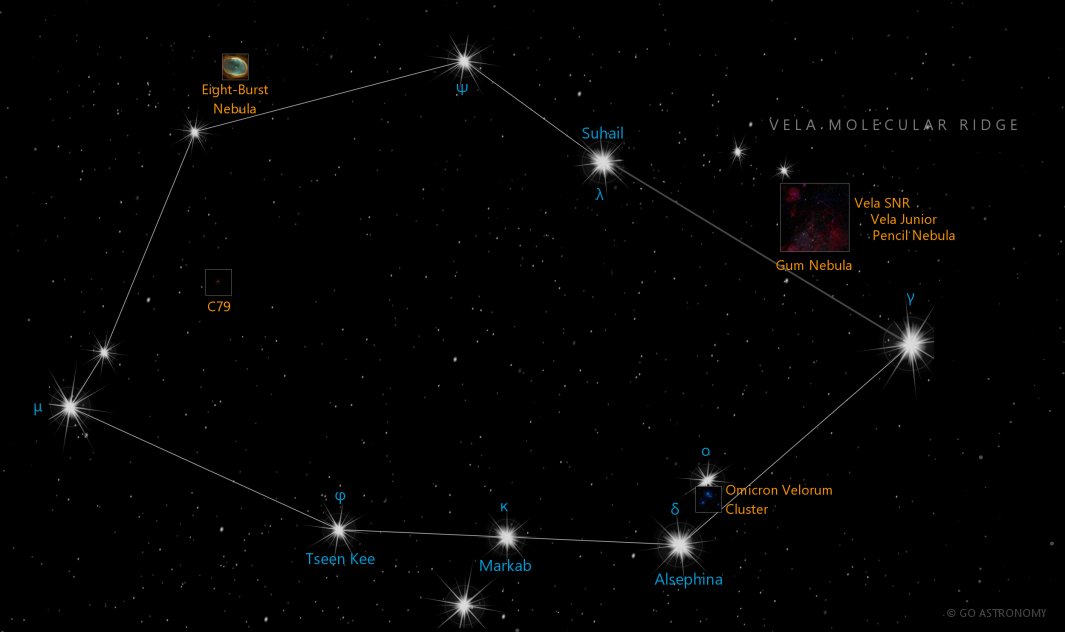Vela, the Sails (Vel)
(VEE-luh)
The Southern constellation of Vela, the Sails, is best viewed in Spring during the month of March.
Vela is the 32nd largest constellation. It's brightest star is Gamma Velorum at magnitude 1.75. The boundary of the Vela constellation contains 7 stars that host known exoplanets.
Luhman is the 3rd closest star to Earth at 6.5 light years.
- Pronunciation:
- VEE-luh
- Meaning:
- Sails
- Genitive:
- Velorum
- Abbreviation:
- Vel
- Constellation Family:
- Heavenly Waters
- Hemisphere:
- Southern
- Quadrant:
- SQ2
- Visibility:
- 30° N - 90° S
- Best viewing month*:
- March
- Area:
- 500 sq. degrees
- Size:
- 32nd largest
- Right Ascension (avg):
- 9h 20m
- Declination (avg):
- -47°
- Brightest star:
- Gamma Velorum (1.75)
- Stars with planets:
- 7
- X-ray stars:
- 3 stars
- Messier objects:
- |
Brightest Stars in Vela
The 10 brightest stars in the constellation Vela by magnitude.
- Star
- Magnitude
- Spectral class
- Gamma Velorum (γ2 Vel)
- 1.83
- WC8 + O7.5
- Delta Velorum (δ Vel)
- 1.96
- A1Va(n)
- Lambda Velorum (λ Vel)
- 2.21
- K4Ib-II
- Kappa Velorum (κ Vel)
- 2.47
- B2IV
- Mu Velorum (μ Vel)
- 2.69
- G5III SB
- Nu Velorum (N Vel)
- 3.16
- K5III
- Phi Velorum (φ Vel)
- 3.52
- B5Ib
- Omicron Velorum (ο Vel)
- 3.6
- B3IV
- HD 78004
- 3.75
- K2III
- HD 74180
- 3.81
- F3Ia
Star Clusters in Vela
The most notable and easy-to-find star clusters in the constellation Vela . Also see all star clusters.
- Star cluster
- Catalog #
- Cluster type
- NGC 2547
- open
- NGC 3201
- globular
- Omicron Velorum Cluster
- C85
- open
- Trumpler 10
- open
Nebulae in Vela
Notable and easy-to-find nebulae in the constellation Vela . Also see all nebulae.
- Nebula name
- Catalog #
- Nebula type
- Eight-burst Nebula
- C74
- planetary
- Gum Nebula
- supernova remnant
- Pencil Nebula
- supernova remnant
- Vela Junior
- supernova remnant
- Vela SNR
- supernova remnant
- Vela Molecular Ridge
- molecular cloud
Neutron Stars in Vela
These are the most well-known neutron stars in the constellation Vela. Although neutron stars cannot be seen in any amateur telescope, they are at the center of many supernova remnant nebulae, which can be seen. Also see all neutron stars.
The Sails of the Cosmic Seas
Vela, known as the Sails, is a constellation situated in the southern hemisphere. This constellation, although not prominent in myths, holds a trove of celestial objects of scientific interest. In this article, we shall explore Vela's history, location, significant celestial bodies, and how best to observe it.
Historical Overview
Vela is part of a larger ancient constellation known as Argo Navis, which represents the ship Argo, used by Jason and the Argonauts in Greek mythology. Argo Navis was later subdivided into three constellations: Carina (the Keel), Puppis (the Stern), and Vela (the Sails) by the French astronomer Nicolas Louis de Lacaille in the mid-18th century to make the large constellation more manageable for astronomers.
Location and Main Characteristics
Vela is located in the second quadrant of the southern hemisphere (SQ2) and can be seen at latitudes between +30? and -90?. It is the 32nd largest constellation, covering an area of 500 square degrees. Its neighboring constellations are Antlia, Carina, Centaurus, Puppis, and Pyxis.
Celestial Bodies of Interest
Vela is home to several notable stars. Gamma Velorum, also known as Suhail, is the brightest star in the constellation and one of the brightest stars in the night sky. It is a complex multiple star system, with its primary component being a Wolf-Rayet star, a rare type of star that is particularly luminous and has a strong stellar wind.
The second-brightest star, Lambda Velorum, or Suhail al Muhilif, is a supergiant star around 5,500 light-years away from Earth. It has a diameter nearly 100 times that of our Sun and is about 8,000 times more luminous.
Among deep-sky objects, Vela Supernova Remnant (Gum 16) is a significant attraction. It is an expanding shell of a supernova that occurred approximately 11,000-12,300 years ago. Also, the Vela Pulsar, situated at the center of the Vela Supernova Remnant, is one of the closest pulsars to Earth.
NGC 3132, or the Eight-Burst Nebula, is a planetary nebula that appears as a faint and large ring with a bright, central star. It's often compared to the more famous Ring Nebula, M57, in the constellation Lyra.
Observation
Vela is best visible in the month of March, but because it is located in the southern hemisphere, it's more easily visible to observers in the southern latitudes. For northern observers, the constellation never rises very high above the horizon.
Even though Vela doesn't contain any Messier objects, it's still a constellation filled with celestial gems that provide both novice and experienced stargazers with an exciting observational experience.
Vela, the Sails, despite its division from a larger constellation, sails smoothly in our celestial sphere, offering a variety of astronomical objects to observe and study. From supergiant stars to the remnants of a supernova, Vela serves as a perfect testament to the life cycle of stars and the dynamism of our universe.
* Constellation shown for northen hemisphere skies. For the southern hemisphere, constellations appear rotated 180 degrees (upside-down and left-right reversed) from what is shown. Remember that seasons are reversed too - summer in northern latitudes is winter in southern latitudes.
** Circumpolar constellations are visible year-round in the hemisphere listed (and not at all in the opposite hemisphere).





